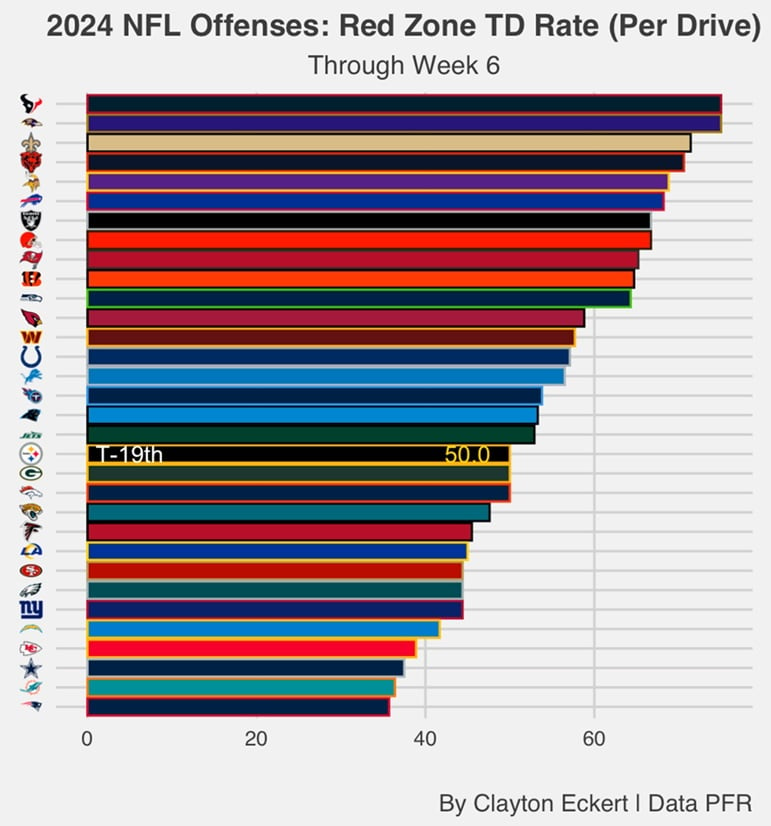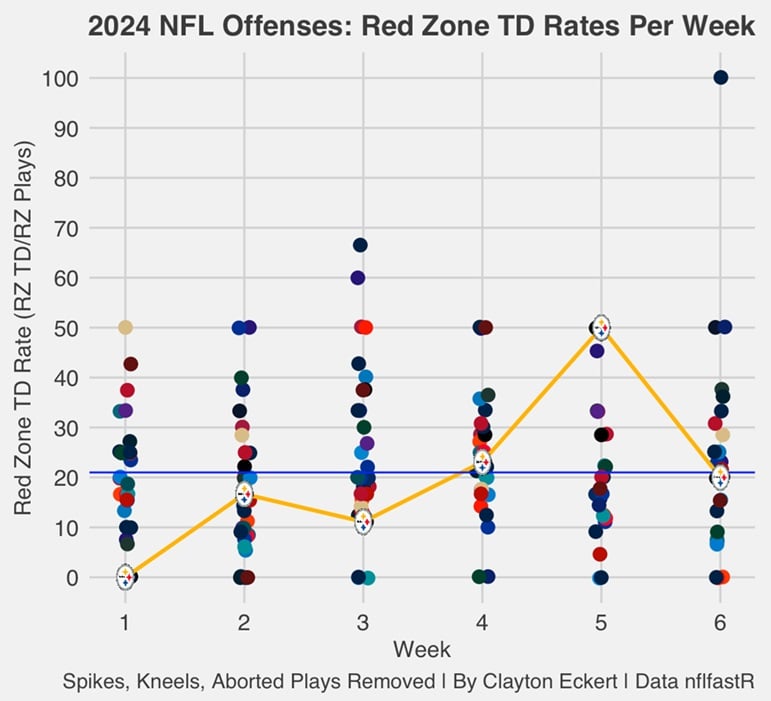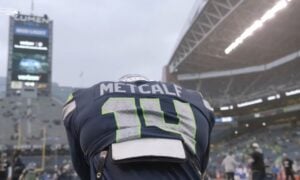Today I wanted to see how NFL offenses have fared in scoring touchdowns in the red area, considering the Pittsburgh Steelers offense just put up their highest point total (32) up in Week 6 against the Raiders. That fact in itself seems groovy on the surface, especially in a low scoring duke it out Steelers identity, but the offense and QB Justin Fields hasn’t been up to snuff overall.
Fields respectfully admitted as such in a recent interview, stating he hasn’t been good enough despite their 4-2 record, and as the team seems set to start Russell Wilson for the first time this season. The goal of the article is to see what has transpired in 2024, provide 2023 info on Wilson’s last action, and see what it could mean for Pittsburgh moving forward.
First, let’s look at red zone touchdown rates per drive for offenses in the 2024 season:
Here we see the Pittsburgh Steelers offense is a below average unit in scoring touchdowns in the red zone. Their 50.0 red zone TD rate ties for 19th in the NFL through Week Six, just below their next opponent in the New York Jets.
Pittsburgh has reached the red zone 18 times this season, tied for 13th. The offense is getting there, sometimes by their own doing, along with some timely turnovers from the defense and special teams units as we saw last week.
Once the offense is in the red zone, they have nine touchdowns on the season, which ties for 18th. So, knocking on the goal line door hasn’t been the issue, but capitalizing once there unfortunately.
Next, I wanted to see the progression from a weekly standpoint, to see how things have trended. Here are those red zone touchdown rates, this time looking on a play-by-play basis (spikes, kneels, aborted plays removed) to gain that context:
Very telling visual. While things could have been much better for the Steelers offense as of late, we can clearly see that things trended positively the last three games compared to the first three weeks of the season.
Pittsburgh’s offense was below the 21-percent per game average in each of the first three games, particularly none in the opener despite having their second-most 11 red zone plays on the season. A whopping ten of those were runs, five each from Fields and RB Najee Harris. Only two were first downs, where Fields converted third downs (one and five yards to go).
Things got a bit better in Week Two, but still below average. The Steelers red zone TD rate came in at 16.7-percent, on six attempts (second-least of 2024). Five passes dominated the splits this time, with a five-yard touchdown to Darnell Washington in the third quarter the highlight by far. Otherwise, no first downs, and the play that was considered a run was unfortunately a sack.
Week Three was a downtrend from an already below average outing. Their 11.1 red zone TD rate came on nine plays, six runs and three passes. The touchdown came on a 3rd and 3 Fields designed run of five yards, and once again no other first downs.
Then, Pittsburgh got above the line in Week Four (slightly). Their 23.1 TD rate included 13 plays, the most on the season, and featured three touchdowns. Two were Fields scrambles, a 2nd and goal from the two, and third and goal from the five in the second half. The other also came on third down, a pass to TE Pat Freiermuth for the eight-yard score late in the fourth quarter. But this came in the Steelers first loss of the season (27-24), and playing from behind throughout affecting the five run/eight pass split in the near comeback.
Then, Pittsburgh skyrocketed to their best mark of the season, at 50-percent. Painfully though, it was the other loss of the season in close fashion to the Dallas Cowboys (20-17). The score was tight throughout, but saw their least red zone opportunities (four). Three passes to only one run, all in the second half. Two passing touchdowns, with Fields finding Connor Heyward wide-open in the flat (nice play design) and 16-yard waltz-in, and the other a shovel pass to Freiermuth late in the fourth quarter.
The Steelers got back in the winner’s circle last week (32-13), but slid to a just below average 20-percent red zone TD rate. Ten attempts, with eight of those being runs. Two of them were touchdowns, both from Fields. One was a 4th and 1 just before halftime for the three-yard score, and the other from seven yards out in the fourth quarter. Once again, none of the other red zone plays were first downs.
So, we can clearly see that the weekly specifics weren’t ideal overall, but Fields accounted for 100-percent of Pittsburgh’s red zone touchdowns to this point. More with his legs, with five rushing to four passing TDs. Many have discussed the tradeoff you lose with Wilson as a rusher, which of course is true including Fields’ most rushing touchdowns of any non-QB this season. But as a passer, his four red zone touchdowns lands low among his peers, along with only five total in 2024.
This is the improvement you are hoping to get with Wilson, a bump in the passing game. Since there is no data for Wilson in 2024, I will reference my studies I did in the offseason on both quarterbacks from 2023. I will include many links to several aspects of their play in my weekly game outlook, but here is a telling one for today’s topic 2023 red zone passing performance.
What I found in that study is that Wilson was by far the better passer in the red zone, including a 26.3 red zone TD rate that ranked sixth-best of the 2023 season out of the 33 qualifying QBs. Comparatively, Fields came in at 22.0-percent, which tied for a much lower 20th rank. And a side note, former QB Kenny Pickett ranked dead-last at just 9.4-percent, yikes.
My takeaway at the time was that Pittsburgh addressed their putrid red zone passing offense in spades with the addition of Wilson, and if he indeed gets the likely start this week (and/or moving forward), that he provides just that. Also encouraging was Wilson’s strong red zone passing TD rate came one the sixth-most attempts (76), so it was quality and quantity, the best of both worlds.
Fields had 50 red zone passing attempts with less quality, though he played fewer games (13) than Wilson (15). Other elements I looked at were accuracy, which becomes increasingly important in the red zone with tighter windows, and of course the importance of the situation.
Wilson had a much higher 61.8 completion rate (ninth), along with an 85.9 catchable rate (eighth), and 81.3 on target rate (third). Fields had lower marks across the board: 54.0 completion rate (19th), 82.9 catchable rate (14th), 78.0 on target rate (fifth).
These facts landed Wilson in the top ten as a red zone passer across the board in the 2023 season, while Fields was outside of it in every aspect except on target rate. At times, we have seen Fields show impressive accuracy in 2024, but inconsistent throughout the season, and had his worst game last week regardless of situation.
So, with Wilson likely getting his first start in the black and gold this week, one of my main hopes is that he can be as effective as a red zone passer (or better) as he showed in 2023. Of course, there are several other aspects of the game that are important, like the overall offense being successful and getting into these situations.
Here’s to hoping that’s the case, with Wilson providing a stronger impact in the red area as a passer, and perhaps Fields coming in closer to the goal line to provide his red zone rushing threat as well.
Thanks for reading and let me know your thoughts in the comments.










